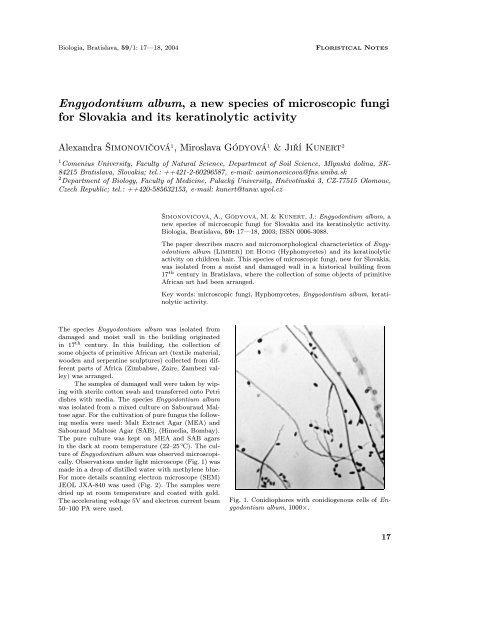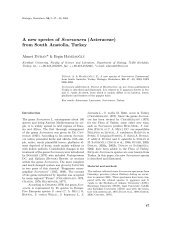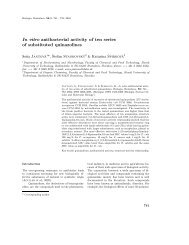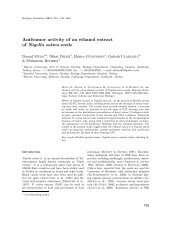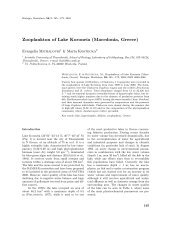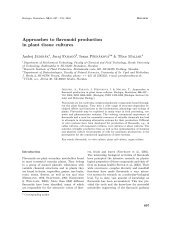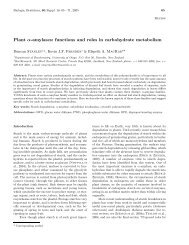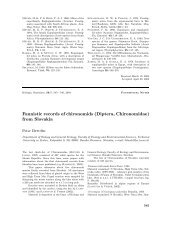Engyodontium album, a new species of ... - Biologia, Bratislava
Engyodontium album, a new species of ... - Biologia, Bratislava
Engyodontium album, a new species of ... - Biologia, Bratislava
You also want an ePaper? Increase the reach of your titles
YUMPU automatically turns print PDFs into web optimized ePapers that Google loves.
<strong>Biologia</strong>, <strong>Bratislava</strong>, 59/1: 17—18, 2004 FLORISTICAL NOTES<br />
<strong>Engyodontium</strong> <strong>album</strong>, a <strong>new</strong> <strong>species</strong> <strong>of</strong> microscopic fungi<br />
for Slovakia and its keratinolytic activity<br />
Alexandra Šimonovičová 1 , Miroslava Gódyová 1 & Jiří Kunert 2<br />
1 Comenius University, Faculty <strong>of</strong> Natural Science, Department <strong>of</strong> Soil Science, Mlynská dolina, SK-<br />
84215 <strong>Bratislava</strong>, Slovakia; tel.: ++421-2-60296587, e-mail: asimonovicova@fns.uniba.sk<br />
2 Department <strong>of</strong> Biology, Faculty <strong>of</strong> Medicine, Palacký University, Hněvotínská 3, CZ-77515 Olomouc,<br />
Czech Republic; tel.: ++420-585632153, e-mail: kunert@tunw.upol.cz<br />
The <strong>species</strong> <strong>Engyodontium</strong> <strong>album</strong> was isolated from<br />
damaged and moist wall in the building originated<br />
in 17 th century. In this building, the collection <strong>of</strong><br />
some objects <strong>of</strong> primitive African art (textile material,<br />
wooden and serpentine sculptures) collected from different<br />
parts <strong>of</strong> Africa (Zimbabwe, Zaire, Zambezi valley)<br />
was arranged.<br />
The samples <strong>of</strong> damaged wall were taken by wiping<br />
with sterile cotton swab and transferred onto Petri<br />
dishes with media. The <strong>species</strong> <strong>Engyodontium</strong> <strong>album</strong><br />
was isolated from a mixed culture on Sabouraud Maltose<br />
agar. For the cultivation <strong>of</strong> pure fungus the following<br />
media were used: Malt Extract Agar (MEA) and<br />
Sabouraud Maltose Agar (SAB), (Himedia, Bombay).<br />
The pure culture was kept on MEA and SAB agars<br />
in the dark at room temperature (22–25 ◦ C). The culture<br />
<strong>of</strong> <strong>Engyodontium</strong> <strong>album</strong> was observed microscopically.<br />
Observations under light microscope (Fig. 1) was<br />
made in a drop <strong>of</strong> distilled water with methylene blue.<br />
For more details scanning electron microscope (SEM)<br />
JEOL JXA-840 was used (Fig. 2). The samples were<br />
dried up at room temperature and coated with gold.<br />
The accelerating voltage 5V and electron current beam<br />
50–100 PA were used.<br />
ŠIMONOVIČOVÁ, A.,GÓDYOVÁ, M.&KUNERT, J.:<strong>Engyodontium</strong> <strong>album</strong>, a<br />
<strong>new</strong> <strong>species</strong> <strong>of</strong> microscopic fungi for Slovakia and its keratinolytic activity.<br />
<strong>Biologia</strong>, <strong>Bratislava</strong>, 59: 17—18, 2003; ISSN 0006-3088.<br />
The paper describes macro and micromorphological characteristics <strong>of</strong> <strong>Engyodontium</strong><br />
<strong>album</strong> (LIMBER) DE HOOG (Hyphomycetes) and its keratinolytic<br />
activity on children hair. This <strong>species</strong> <strong>of</strong> microscopic fungi, <strong>new</strong> for Slovakia,<br />
was isolated from a moist and damaged wall in a historical building from<br />
17th century in <strong>Bratislava</strong>, where the collection <strong>of</strong> some objects <strong>of</strong> primitive<br />
African art had been arranged.<br />
Key words: microscopic fungi, Hyphomycetes, <strong>Engyodontium</strong> <strong>album</strong>, keratinolytic<br />
activity.<br />
Fig. 1. Conidiophores with conidiogenous cells <strong>of</strong> <strong>Engyodontium</strong><br />
<strong>album</strong>, 1000×.<br />
17
Fig. 2. Detail <strong>of</strong> zigzag bent part <strong>of</strong> conidiophores <strong>of</strong><br />
<strong>Engyodontium</strong> <strong>album</strong>, 1900× (SEM). Slightly flattened<br />
conidiophores and conidia were caused by rehydration<br />
(artifact in SEM).<br />
For testing the keratinolytic activity autoclaved<br />
children hairs were added to the fully grown cultures<br />
on Sabouraud agar and brought into contact with the<br />
surface mycelium. Alternatively, autoclaved hairs were<br />
inoculated directly with the mycelium and spores and<br />
kept in a humid chamber at 29 ◦ C in the dark. The<br />
degradation <strong>of</strong> hairs was observed under a light microscopeafter1to8weeks.<br />
The <strong>species</strong> <strong>Engyodontium</strong> <strong>album</strong> was determined<br />
using the key DE HOOG &GUARRO (1995). The<br />
isolate is held in CCF <strong>of</strong> the Department <strong>of</strong> Soil Science.<br />
<strong>Engyodontium</strong> <strong>album</strong> (LIMBER) de HOOG<br />
Recent synonym: Tritirachium <strong>album</strong> Limber<br />
Systematic position: Hyphomycetes, Moniliales<br />
On MEA and SAB the <strong>species</strong> <strong>Engyodontium</strong> <strong>album</strong><br />
forms fast growing (2–3 days) and white coloured<br />
colonies appearing lanose to floccose up to 2 mm<br />
high. The reverse is uncoloured or light ochraceous.<br />
Colonies reaching 3.0–4.0 cm diam in seven days at<br />
room temperature 22–25 ◦ C. Conidiophores are ascending,<br />
2–4 µm wide, bearing elongate to subcylindrical<br />
conidiogenous cells (Fig. 1). Typical feature <strong>of</strong><br />
18<br />
the genus Endyogontium is zikzak bent part <strong>of</strong> coniodiophores<br />
(Fig. 2) similary in the genus Beauveria<br />
(ŠIMONOVIČOVÁ & BENKOVÁ, 2000). The conidia<br />
are hyaline, smooth-walled, subspherical, 2–3 ×<br />
1.5–2.5 µm. On MEA or SAB agars in test-tubes<br />
the <strong>species</strong> <strong>Engyodontium</strong> <strong>album</strong> grows extremely fast,<br />
in two-three days. In human population this <strong>species</strong><br />
causes keratitis, cerebritis and endocarditis (DE HOOG<br />
& GUARRO, 1995). <strong>Engyodontium</strong> <strong>album</strong> is <strong>of</strong>ten<br />
regarded as a keratinophilic fungus (DE HOOG &<br />
GUARRO, 1995). Our strain overgrew the human hairs<br />
in culture. However, even after 8 weeks the hair degradation<br />
was week.<br />
The <strong>species</strong> <strong>Engyodontium</strong> <strong>album</strong> is rare and <strong>new</strong><br />
for Slovakia and it has been not listed in the Checklist<br />
<strong>of</strong> non-vascular and vascular plants <strong>of</strong> Slovakia, part<br />
Fungi (LIZOŇ &BACIGÁLOVÁ, 1998). In the CCF in<br />
Prague, this <strong>species</strong> has been reported ex man from<br />
the Netherlands (KUBÁTOVÁ et al., 1996).<br />
Acknowledgements<br />
This work was partially supported by grant VEGA<br />
9114/02 and 9118/02.<br />
References<br />
HOOG DE, G. S. 1972. The genera Beauveria, Isaria,<br />
Tritirachium and Acrodontium gen. nov. Stud. Mycol.<br />
1: 1–41.<br />
HOOG DE, G.S.&GUARRO, J. 1995. Atlas <strong>of</strong> clinical<br />
fungi. Centraalbureau voor Schimmelcultures,<br />
Baarn, Universitat Rovira i virgili, Reus, 720 pp.<br />
KUBÁTOVÁ, A.,VÁŇOVÁ, M.&PRÁŠIL K. 1996. CCF<br />
Catalogue <strong>of</strong> Filamentous Fungi. Novit. Bot. Univ.<br />
Carol., Praha, 120 pp.<br />
LIZOŇ, P.&BACIGÁLOVÁ, K. 1998. Fungi, pp. 101–<br />
227. In: MARHOLD,K.&HINDÁK,F.(eds),Checklist<br />
<strong>of</strong> non-vascular and vascular plants <strong>of</strong> Slovakia.<br />
Veda, <strong>Bratislava</strong>.<br />
ŠIMONOVIČOVÁ,A.&BENKOVÁ, S. 2000. Occurrenece<br />
<strong>of</strong> <strong>species</strong> Beauveria bassiana (BALS. – CRIV.)<br />
VUILL. in floodplain forest soils in the vicinity <strong>of</strong><br />
Gabčíkovo Bull. Slov. Bot. Spoločn., <strong>Bratislava</strong>,<br />
22: 23–27.<br />
Received Oct. 25, 2002<br />
Accepted Oct. 22, 2003


